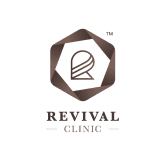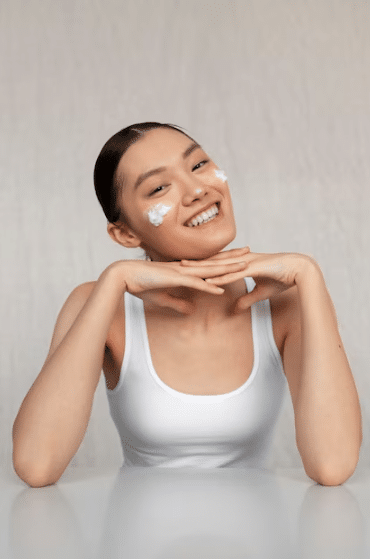Combination skin can be a bit tricky to manage. You might notice an oily T-zone but dry patches on your cheeks. Finding the right balance is key, and that’s where a tailored skincare routine comes into play. Every skin type is unique, and combination skin needs special attention to maintain harmony.
Dr. Jeff Khoo and his team at Revival Clinic are experts in treating combination skin. Dr. Jeff Khoo’s extensive experience and advanced techniques help create personalized solutions that cater to your skin’s specific needs.
In this ultimate skincare guide for combination skin, we’ll explore everything you need to know about caring for your unique skin type. Let’s get started!
Understanding Combination Skin
Combination skin is a unique skin type where you experience both oily and dry areas on your face. Typically, the T-zone (forehead, nose, and chin) tends to be oily, while the cheeks and other areas may have dry patches. This dual nature can make skincare quite challenging.
Common Symptoms of Combination Skin
- Oily T-zone: Shiny appearance and enlarged pores.
- Dry Patches: Flaky or rough texture, often found on the cheeks.
- Sensitivity: Prone to both acne and dryness-related issues.
Factors Influencing Combination Skin
- Hormonal Changes: Fluctuations in hormones during puberty, pregnancy, or menstruation can exacerbate combination skin.
- Age: As we age, our skin’s oil production can decrease, affecting its balance.
- Environmental Factors: Climate changes, pollution, and even seasonal variations can impact your skin’s behavior.
Dr. Jeff Khoo from Revival Clinic has extensive expertise in treating combination skin. His clinic offers advanced treatments tailored to address these specific needs. For those struggling with skin conditions like melasma alongside combination skin, Revival Clinic’s melasma treatments could provide comprehensive care.
Navigating the complexities of combination skin requires understanding its unique characteristics and influencing factors.
Why a Customized Skincare Routine is Essential for Combination Skin
Combination skin is like having two different skin types on one face. The oily T-zone (forehead, nose, and chin) can be prone to breakouts while the cheeks might feel dry or even flaky. A one-size-fits-all approach can’t address these contrasting needs effectively.
The Problem with Generic Skincare Routines
- One-size-fits-all products often fail to balance oiliness and dryness simultaneously.
- Products targeting oily skin can strip moisture, exacerbating dry patches.
- Hydrating products might leave the T-zone overly greasy or lead to clogged pores.
Goals of an Effective Skincare Routine for Combination Skin
- Balancing Oiliness and Dryness
- Use lightweight, non-comedogenic products on oily areas.
- Opt for richer, hydrating formulations on drier sections.
- Providing Adequate Hydration
- Look for ingredients like hyaluronic acid that hydrate without clogging pores.
- Incorporate dual-purpose products that cater to both skin types.
- Preventing Breakouts and Dryness
- Exfoliate regularly to keep pores clear.
- Avoid harsh cleansers that strip the skin’s natural oils.
By tailoring your skincare routine, you can achieve a harmonious balance, ensuring all areas of your face are well-cared-for. For expert advice on specialized treatments like Botulinum Toxin, Revival Clinic offers bespoke solutions aligning with your unique skincare needs.
Essential Skincare Steps for Combination Skin
1. Cleansing: Finding the Right Cleanser for Your Unique Skin Type
Combination skin can be a bit tricky to manage, especially when it comes to cleansing. The key is to use gentle hydrating cleansers that won’t strip your skin of its natural oils, which can lead to more dryness or oiliness.
Why Gentle Cleansers Matter
Using harsh cleansers can disrupt the skin’s balance, causing the dry areas to become flakier and the oily areas to produce even more oil. Gentle cleansers help maintain this delicate balance.
Hydrating Cleansers
Opt for hydrating formulas that clean without over-drying. These types of cleansers typically contain ingredients like glycerin or hyaluronic acid, which help retain moisture in the skin.
Product Recommendations:
- Oil-Based Cleansers: These are great for breaking down makeup and excess oil. They work well as the first step in a double-cleansing routine.
- Water-Based Cleansers: Follow up with a water-based cleanser to remove any remaining impurities without stripping your skin.
Some popular choices include:
- Banila Co Clean It Zero (oil-based)
- CeraVe Hydrating Cleanser (water-based)
Using an oil-based cleanser followed by a water-based one ensures that all forms of dirt and makeup are effectively removed, leaving your skin clean but not overly dry.
Dr. Jeff Khoo at Revival Clinic emphasizes the importance of using products tailored specifically to your skin type, considering his extensive background in dermatology and aesthetic medicine. For more personalized advice, check out Revival Clinic’s Locations or read about their advanced skincare treatments.
2. Toning: Refining Pores and Controlling Oil Production with Toners
Toners play a vital role in your cleansing routine, especially for combination skin. They help refine pores and control excess oil production, particularly in the T-zone area where oiliness tends to be more pronounced.
Why Use a Toner?
- Refines Pores: Helps to minimize the appearance of pores, giving your skin a smoother texture.
- Balancing Act: Controls oil production without stripping your skin of its natural moisture.
Ingredients to Look For:
- Niacinamide (Vitamin B3): Known for its anti-inflammatory properties, niacinamide is excellent for reducing pore size and controlling sebum production.
- AHAs/BHAs: These chemical exfoliants help in unclogging pores and promoting cell turnover, making them ideal for combination skin.
Pro Tip: Opt for alcohol-free toners to avoid dryness and irritation. Some great options include toners with hydrating ingredients like glycerin or hyaluronic acid.
For professional treatments that complement your at-home skincare routine, check out Revival Clinic’s Ultherapy services for non-surgical skin tightening.
3. Serums: Targeted Treatments for Specific Concerns like Brightening or Anti-Aging
Incorporating lightweight serums into your combination skin routine can work wonders for targeting specific concerns such as brightening and anti-aging. Serums are packed with active ingredients designed to penetrate deeply and deliver concentrated benefits.
Benefits of Lightweight Serums
- Hydration: Ingredients like hyaluronic acid help retain moisture without adding greasiness, making them ideal for hydration.
- Brightening: Vitamin C serums can help even out skin tone and reduce dark spots.
- Anti-Aging: Look for serums containing retinol or peptides to improve skin texture and reduce fine lines.
Using a serum after your cleansing routine but before moisturizing allows these powerful ingredients to work effectively. Consider incorporating these targeted treatments into your daily regimen for noticeable improvements in your skin’s health.
For more information on advanced skincare treatments, check out the Revival Clinic for professional advice tailored to your needs.
4. Moisturizing: Choosing the Right Moisturizer for Each Zone of Your Face
Combination skin has its quirks, with some areas like the T-zone being oilier and others like the cheeks needing extra hydration. Understanding this dual nature is essential for picking the right moisturizers.
The Dual Approach to Moisturization
- Oily Areas (T-zone): Opt for lightweight, gel-based moisturizers. These provide hydration without adding to the oiliness, keeping breakouts at bay.
- Dry Areas (Cheeks and Periphery): Cream-based moisturizers work wonders here. They offer intense hydration and help to lock in moisture, combating dryness effectively.
Tips for Selecting Suitable Products
- Check Ingredients: Look for non-comedogenic options, especially if you’re prone to breakouts in the oily areas.
- Hydration Levels: Ensure the products contain hydrating ingredients like hyaluronic acid or glycerin.
- Texture Preferences: If you dislike heavy creams, opt for a lotion that strikes a balance between moisture and lightness.
Balancing these needs can make a significant difference in your skincare routine. If you’re curious about advanced treatments, check out Revival Clinic’s Platelet-Rich Plasma (PRP) Therapy for more targeted solutions.
5. Sun Protection: The Importance of Daily SPF Application for All Skin Types
Daily sun protection is essential, regardless of your skin type. If you have combination skin, it’s important to find a sunscreen that effectively controls oil and provides hydration. Look for broad-spectrum SPF products that offer protection against both UVA and UVB rays, as this is crucial for preventing premature aging and reducing the risk of skin cancer.
Recommendations for combination skin-friendly sunscreens:
- Gel-based sunscreens: Lightweight and non-greasy, perfect for the oily T-zone.
- Mineral sunscreens: Often contain zinc oxide or titanium dioxide, ideal for sensitive areas.
- Moisturizing sunscreens: Provide hydration without clogging pores, great for dry patches.
Incorporating SPF into your cleansing routine ensures comprehensive protection. After using gentle cleansers and toners with beneficial ingredients like niacinamide, apply a suitable sunscreen as your final skincare step. This not only shields your skin but also complements the benefits of other products in your regimen.
By prioritizing sun protection, you’re taking a significant step towards maintaining balanced and healthy skin every day.
6. Exfoliation: Enhancing Cell Turnover with Chemical Exfoliants like Glycolic Acid
Exfoliation is a game-changer for combination skin. Regular exfoliation can help promote cell turnover, prevent clogged pores, and balance the skin’s texture. When dead skin cells are removed, your other skincare products, like gentle cleansers and hydrating toners, work more effectively.
Types of Exfoliants to Consider:
- Chemical Exfoliants: These include ingredients like glycolic acid, salicylic acid, and lactic acid. They penetrate deeper into the skin to dissolve dead skin cells and unclog pores.
- Enzymatic Exfoliants: Derived from fruits like papaya or pineapple, these are gentler options that break down proteins in dead skin cells.
For those dealing with pigmentation or uneven skin tone, glycolic acid can be particularly beneficial. It’s also a fantastic option for enhancing the effects of your cleansing routine and serum types by improving product absorption.
Pro Tips:
- Start slow—use chemical exfoliants 1-2 times a week.
- Always follow up with a good moisturizer and SPF to protect your renewed skin.
Check out Revival Clinic’s page on pigmentation treatments for more targeted solutions.
By incorporating these steps into your routine, you can achieve balanced, radiant skin without compromising its natural barrier.
7. Masks and Treatments: Multi-Masking Techniques Using Clay Masks and Hydrating Masks Together on Different Areas of Your Face
Ever heard of multi-masking? It’s a game-changer for combination skin. This technique involves using different masks on various parts of your face based on their specific needs. Think of it as a tailored approach to skincare that ensures each area gets the attention it deserves.
Why Multi-Masking Works for Combination Skin
Combination skin can be tricky to manage because different areas of your face have different needs. The T-zone (forehead, nose, chin) tends to be oilier, while the cheeks and other areas may be drier. Using a one-size-fits-all mask may not address these specific concerns effectively.
Here’s where multi-masking comes in. By using different masks on different areas of your face, you can target specific issues more effectively. For example:
- If your T-zone tends to get oily, a clay mask can help absorb excess oil and unclog pores.
- Look for masks containing kaolin or bentonite clay, which are excellent at tackling oiliness without being too harsh.
- On the other hand, the drier areas of your face, like your cheeks, will benefit from a hydrating mask.
- Ingredients like hyaluronic acid, aloe vera, and glycerin are perfect for providing deep moisture.
- They help soothe and nourish these patches, ensuring they stay hydrated and supple.
How to Multi-Mask Effectively
Here’s a quick example of a multi-masking routine:
- Clay Mask: Apply to your T-zone (forehead, nose, chin) for about 10-15 minutes.
- Hydrating Mask: Use on your cheeks and any other dry areas for the same duration.
Remember, consistency is key. Incorporate this technique into your regular cleansing routine to see noticeable improvements in your skin’s balance and overall health.
Pro Tip: Alternate Application
You don’t have to apply these masks simultaneously. Feel free to use them on alternate days based on your skin’s needs.
Advanced Treatments for Targeted Solutions
If you’re looking for more targeted skincare solutions, consider exploring advanced treatments like Potenza Radiofrequency Microneedling or SilkPeel Dermalinfusion. These options can complement your at-home multi-masking efforts by providing professional-grade results.
Professional Treatments Available at Revival Clinic for Maintaining Healthy Balance in Combination Skin Types
Revival Clinic offers a variety of professional treatments designed to help maintain a healthy balance for those with combination skin. One standout treatment is chemical peels. These peels help remove dead skin cells, unclog pores, and promote cell turnover, making your skin look fresher and more radiant.
Benefits of Chemical Peels at Revival Clinic:
- Unclogs Pores: Helps to control the oily T-zone by reducing excess oil production.
- Hydration Boost: Promotes hydration in dry areas by removing dead cells that can block moisturizers from penetrating.
- Even Skin Tone: Reduces uneven pigmentation and brightens the overall complexion.
Dr. Jeff Khoo and his team understand that combination skin requires a tailored approach. They also offer other advanced treatments like laser therapy and personalized skincare regimens. For more information on their offerings, you can explore their genesis treatment.
By combining these treatments with a proper at-home skincare routine, you can achieve balanced, healthy skin that looks as good as it feels.
Conclusion: Embrace Your Unique Complexion with Confidence!
Combination skin may present unique challenges, but armed with the right knowledge and products, you can achieve a balanced and radiant complexion. If you’re ever unsure about what’s best for your skin, seeking professional advice can make all the difference. Revival Clinic offers specialized treatments and expert guidance to help you navigate your skincare journey.
Embrace your unique skin type and treat it with the care it deserves!
Frequently Asked Questions
What is combination skin?
Combination skin is characterized by an oily T-zone (forehead, nose, and chin) and dry patches on the cheeks. This skin type often requires a tailored skincare routine to address both oiliness and dryness effectively.
Why is a customized skincare routine important for combination skin?
A one-size-fits-all approach doesn’t work for combination skin because it requires balancing oiliness in some areas while providing hydration in others. A customized routine can help achieve this balance, ensuring that all areas of the face receive the appropriate care.
What are the essential steps in a skincare routine for combination skin?
The essential steps include:
1) Cleansing with gentle hydrating cleansers;
2) Toning with alcohol-free toners containing beneficial ingredients like niacinamide;
3) Applying lightweight serums for targeted treatments;
4) Moisturizing with suitable products for different zones;
5) Daily sun protection with broad-spectrum SPF;
6) Regular exfoliation using chemical exfoliants;
7) Multi-masking techniques to address specific needs on various areas of the face.
How do I choose the right cleanser for my combination skin?
For combination skin, it’s important to use gentle hydrating cleansers that won’t strip natural oils. A recommended method is to use an oil-based cleanser followed by a water-based one to effectively cleanse without causing dryness.
What professional treatments does Revival Clinic offer for combination skin?
Revival Clinic offers various professional treatments, including chemical peels, which can help maintain a healthy balance in combination skin types. These treatments are designed to enhance skin texture and address specific concerns associated with this complexion type.
Can I use different moisturizers on different areas of my face?
Yes, using different types of moisturizers on various zones of your face is advisable for combination skin. For instance, you may choose a cream moisturizer for dry areas and a gel or lotion for oilier zones to provide optimal hydration where needed.


